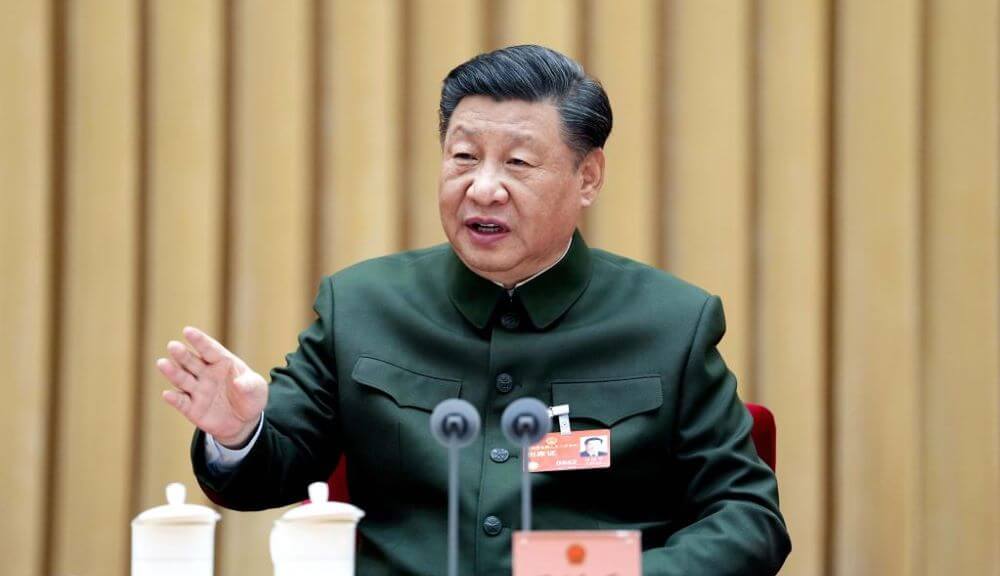Foreign
Work together to broaden Belt and Road as ‘path of happiness’ benefiting whole world

By He Yin, People’s Daily
The high-profile third Belt and Road Forum for International Cooperation is expected to be held in Beijing. It will be not only the grandest event to commemorate the 10th anniversary of the Belt and Road Initiative (BRI), but also an important platform for relevant parties to advance high-quality Belt and Road cooperation.
Together, participants in the forum will learn from past experiences, draw a blue print for future cooperation, and lead Belt and Road cooperation toward better development. They will scale new heights, enhance their partnership, and demonstrate their strength in coping with challenges of the times and building a global community of shared future.
Chinese President Xi Jinping extended sincere invitation to relevant parties at the 23rd Meeting of the Council of Heads of State of the Shanghai Cooperation Organization. He said, “Ten years ago, I proposed the BRI, and on its tenth anniversary, China will hold the third Belt and Road Forum for International Cooperation. I welcome your participation. We should work together to broaden the Belt and Road as a ‘path of happiness’ benefiting the whole world.”
His invitation received warm response. Russia said the BRI conforms to the development of Eurasia, and the Russian side is looking forward to the third Belt and Road Forum for International Cooperation. Vietnam said it firmly supports the major initiatives proposed by Xi and supports China in holding the third Belt and Road Forum for International Cooperation. Hungary said it would actively join the forum.
As of the end of September, representatives from over 130 countries and multiple international organizations had confirmed participation in the forum. It fully indicates the international community’s confidence in and expectation for high-quality Belt and Road cooperation.
Over the past decade, the BRI has transformed from an abstract overall outline into a meticulously detailed blueprint, becoming the most welcomed global public good as well as the largest platform for international cooperation.
By July this year, more than three quarters of all countries in the world and over 30 international organizations have signed Belt and Road cooperation documents with China. The BRI has so far established more than 3,000 cooperation projects and galvanized nearly $1 trillion of investment.
Over the past decade, participating countries have sowed the seed of cooperation and jointly reaped the fruits of cooperation, achieving shared prosperity through mutually beneficial cooperation.
The Asian Infrastructure Investment Bank and the Silk Road Fund have provided financing support for hundreds of projects. The China-Laos Railway has converted Laos from a landlocked country to a land-linked one. The Jakarta-Bandung High-speed Railway is the first one in Southeast Asian countries to run at a speed of 350 km/h. The Mombasa–Nairobi Standard Gauge Railway has boosted local economic growth by over two percent.
The fruitful outcomes of the BRI fully proves that the “belt of development” and “road to happiness” for all humanity will deliver more prosperity to more people and constantly enhance the sense of fulfillment and happiness for people of participating countries, as long as it follows the principle of wide consultation, joint contribution and shared benefits, pursues open, green and clean cooperation, aims at high-standard, sustainable and people-centered growth and continues seeking high-quality development.
The third Belt and Road Forum for International Cooperation will further build consensus and pull efforts from relevant parties, so as to deepen Belt and Road cooperation.
Today, the world has entered a new period of turbulence and transformation. It is undergoing major shifts, division and regrouping, leading to more uncertain, unstable and unpredictable developments. The journey of global economic recovery remains long and tortuous. Unilateralism and protectionism are mounting. Particularly, certain countries are pursuing decoupling and severing of supply chains in the name of “de-risking,” posing threats against the security and stability of international industrial and supply chains.
Facing common challenges, relevant parties need to strengthen political mutual trust, connectivity, trade facilitation, financial integration, and people-to-people exchanges, actively launch cooperation in health, green development, digital industry and innovation, foster new areas of growth, and demonstrate their will and capability to share opportunities, tackle challenges and jointly build a better future.
The third Belt and Road Forum for International Cooperation will include an opening ceremony, three high-level forums on connectivity, green development and digital economy, and six thematic forums on trade connectivity, people-to-people communication, think tank exchanges, clean Silk Road, subnational cooperation and maritime cooperation. A CEO conference will also be held during the event.
Like-minded partners will come together to discuss cooperation plans and outline a development blueprint. Together, they will practice true multilateralism and set new milestones of Belt and Road cooperation. This will inject confidence into addressing the challenges of the times and achieving global sustainable development.
“But either in good times or bad, either on a smooth road or a thorny path, we will uphold the spirit of partnership, keep in mind what brought us together, and march forward without hesitation,” said Xi at the welcoming banquet of the second Belt and Road Forum for International Cooperation.
Looking forward to the third Belt and Road Forum for International Cooperation, each participant should have the belief that people of all countries deserve a better future, and Belt and Road cooperation will definitely bring about a better world.
Foreign
Expressway service station in Shandong achieves carbon neutrality

By Li Rui, People’s Daily
A man surnamed Lin, driving a new energy vehicle, was on his way from Jinan to his hometown Weifang, both in east China’s Shandong province. As the battery of his vehicle ran low, he pulled up in a service station along the Qingdao–Yinchuan Expressway.
Experience told him that a service station was a place where drivers and passengers could refuel vehicles, use the bathroom, grab a drink of water and have a meal. However, he found this service station a little bit different.
The Jinan East service station was a key carbon-zero station built by Shandong Hi-Speed Company Limited. It was put into operation on July 26, 2019. During China’s just-concluded National Day holiday, the service station received an average of 13,000 vehicles and 44,000 people on a daily basis.
“How long does it take for a vehicle to get 200 kilometers of range with this ultra-fast charging pole?” Lin asked a staff member of the service station.
“One second for one kilometer of range,” the staff member replied, pointing to an advertising board above that said “Get Fully Charged over a Cup of Coffee.”
Being skeptical about it, Lin scanned a QR code on the charging pole with his phone. Then, he unwound outside his car and went to get a cup of hot water. When he came back, he found his car fully charged.
The power level of the charging pole Lin used was 600 kW, and there were also charging poles of different models and power levels available for users to choose from at the service station.
The Jinan East service station covers an area of 300 mu, or 20 hectares. With so many charging poles in service, it consumes about 6,000 kWh of electricity each day. Where does such a huge load of electricity come from?
On the canopy, rows of solar panels were neatly paved. They were a part of a renewable energy utilization system – a 3.2 MW solar farm built on side slopes of the expressway, parking lot canopies and rooftops. The system also comes with a 3.2 MWh power storage facility.
At present, the service station generates an average of over 10,000 kWh of electricity on a daily basis, far exceeding its daily power consumption volume. This saves 1,200 tons of standard coal per year. The service station also transmits extra electricity to the power grid through safe and efficient means.
At noon, the fragrance of food was floating in the corridors of the crowded comprehensive building of the service station. As one of the busiest service stations in Shandong province, the Jinan East service station welcomes over 10 million passengers each year. How does it manage the wastewater generated by such a huge crowd?
In the “backyard” of the service station, there were two white bungalows at the corner of a tree lawn. Inside them, sewage treatment facilities were running, processing wastewater and pumping it back to the water tanks, which would be used for irrigation and floor washing.
The treatment system for waste and pollutant resources successfully addresses the challenges of the huge variation between water usage peaks and lows, as well as significant greenhouse gas emissions from sewage, effectively recycling and reusing treated water.
“In the past, diesel vehicles were used for service area operations and cleaning, but now they have been replaced with electric vehicles. The catering businesses have also undergone electrification upgrades for their gas stoves, replacing them with clean energy sources wherever possible,” a staff member said.
Carbon emissions are invisible and intangible. How are they measured?
Shandong Hi-Speed Company Limited has independently developed a smart energy management system, which builds a digital twin of the station and displays all relevant data on a screen, including daily electricity generation, charging station power, peak electricity generation periods, air conditioning usage and more.
It is learned that this zero-carbon smart energy management system collects data of all indirect carbon emission sources such as photovoltaics, energy storage, micro grids, lighting, HVAC (heating, ventilation, and air conditioning), and wastewater treatment. It can automatically calculate, make decisions, and intelligently control equipment.
For example, if the air conditioning is set at 26 degrees Celsius indoors, the system can automatically shut down some air conditioners when the temperature falls below this threshold, refining energy management and enabling intelligent equipment control.
According to real-time monitoring by the system, the service station emits an average of 2,060.97 tons of carbon dioxide per year. By planting over 19,000 square meters of greenery, the service station offsets greenhouse gas emissions.
Currently, the forestry area of the service station covers 67,000 square meters, or about 33 percent of the station’s total area. Through forestry carbon sequestration, the system helps reduce an annual average of 3,410.1 tons of carbon dioxide, with a forestry carbon sequestration volume of 53.4 tons of carbon dioxide, realizing “zero-carbon” operations. The service station now has the capability for sustainable carbon neutrality.
“So far, China has built nearly 4,000 pairs of expressway service stations. If we can promote zero-carbon experiences in more service stations, it would be of great significance,” said Zhou Pengfei, deputy director of the energy and environment department of Shandong Hi-Speed Company Limited.
Foreign
Qinling Mountains better safeguarded with comprehensive digital platform

By Zhang Tie, Zhang Danhua, People’s Daily
The Qinling Mountains in northwest China’s Shaanxi province are a natural boundary between China’s north and south in terms of geology, climate, biodiversity, water systems, and soil types.
The unique geographic environment creates abundant moisture, and the rugged terrain harbors rich plant and animal resources, earning the Qinling Mountains the nickname “China’s Central Park” and establishing them as a crucial ecological barrier for the country.
In recent years, ecological protection and restoration of the Qinling Mountains has maintained a priority of Shaanxi province.
“There appears to be waste dumping in the east of Liyuanpo village in Shijing neighborhood,” an alert popped up on the screen of a digital comprehensive monitoring platform for the Qinling Mountains of Huyi district of Xi’an, capital of Shaanxi Province.
Staff member Zhao Na immediately contacted Mao Juan, a local grid officer: “Drones have captured footage, and AI analysis has detected unauthorized dumping.”
In less than an hour, Mao arrived at Liyuanpo village. Upon investigation, she learned that a villager had been renovating his house and had dumped construction waste by the roadside.
She promptly took photos for evidence, uploaded them from her phone, and informed the neighborhood office. After the area was cleared by the following morning, Mao revisited the site, verified the cleanup, and uploaded the update to the platform.
The ecological protection area of the Qinling Mountains covers six districts and counties in Xi’an, accounting for about 55 percent of the city’s total area. The rapid handling of issues like this is a result of an integrated ecological monitoring and protection system for the Qinling Mountains.
The system includes satellites that provide periodic remote sensing images, drones that conduct routine patrol flights, cameras offering real-time monitoring, and 1,240 dedicated grid officers carrying out inspections.
“With this system, countless ‘eyes’ help us protect every ridge and valley of the Qinling Mountains,” said Lei Bo, director of the technology and grid management department of the Xi’an municipal bureau of Qinling ecological environment protection.
From January to August this year, the platform autonomously identified and processed 2,480 cases involving unauthorized construction and dumping. Most cases were resolved within one to three days.
In recent years, Xi’an has continuously improved the systems and mechanisms for regular and long-term protection of the Qinling Mountains. The approach combines human surveillance with technology-based monitoring, and grid-based management with networked coordination, making protection efforts more targeted and intelligent.
Now, the entire landscape can be visualized on a single map, which shows forests, rivers, buildings, and mineral distributions, creates a digital model of the Qinling Mountains.
Each village has its own grid, with at least one grid officer, which forms a four-tiered management system from the municipal level down to villages.
Municipal- and district-level platforms, as well as several industry-specific platforms have been integrated, enabling information sharing and seamless data exchange to form a unified digital supervision system for the Qinling Mountains.
“We can detect even the smallest fire, down to a single lighter, thanks to the integration of thermal, smoke, and light sensors,” said Hua Yiping, director of the Qinling ecological protection and comprehensive law enforcement bureau of Huyi district. The digital monitoring platform now extends to multiple applications, including forest fire prevention, flood control, water quality monitoring, and geological disaster monitoring.
Currently, the populations of wild plants and animals in the Qinling Mountains are steadily increasing, with 99.3 percent of the Qinling area within Shaanxi province now rated as having an excellent ecological environment.
“In the future, we will continue to enhance the automation, intelligence, and precision of Qinling’s protection measures. We aim to refine our monitoring systems and ensure thorough, dynamic inspections and remediation,” said Li Bo, deputy director of the Xi’an municipal bureau of Qinling ecological environment protection.
Foreign
SWChina’s Guizhou builds itself into computing power base serving whole country

By Chen Junyi
At the Gui’an Supercomputing Center, which is located in Guiyang, southwest China’s Guizhou province, over 600 servers are running at full speed, supplying constant computing power to cities like Shenzhen, Guangzhou, and Wuhan, creating a vibrant ambiance with constant hum of cooling fans and flickering indicator lights.
As one of the eight major hubs of China’s national integrated computing power network, Guizhou is actively pursuing the integrated development of data storage and computing, with a particular focus on intelligent computing.
It aims to enhance the capacity in computing power supply, effectively match the supply and demand of computing power within the province and elsewhere, and better utilize computing power and localize the computing industry, so as to establish a support base serving the whole country.
Guizhou launched its plans to develop data centers ten years ago. It boasts numerous natural advantages for developing the computing industry, such as safe geological conditions, reliable power supply, and low average temperatures. China’s three telecommunication operators, namely China Telecom, China Mobile, and China Unicom, have all set up data centers here, making it the first province in China to host data centers of all the three.
After a decade of development, Guizhou is currently home to 47 data centers, either under construction or in operation, including 25 super-large and large data centers, most of which are located in the Gui’an New Area.
The Gui’an New Area is known for its flat terrain and an annual average temperature of 15 degrees Celsius. The region enjoys 99.5 percent of days with good air quality throughout the year, thereby serving as a natural air conditioner and oxygen bar.
The power usage effectiveness (PUE)of data centers in the region, a metric for energy efficiency, is lower than 1.2, which is at the forefront of all green data centers across the country. It is also one of the areas in China where data centers boast the lowest energy consumption and the longest equipment lifespan.
“As the carrier of computing power, data centers are equipped to support high-performance application scenarios by leveraging advanced computational capabilities and large-scale data processing power through the use of various hardware components such as servers and graphics cards,” said Peng Benqian, head of the Gui’an Supercomputing Center and director of the technology research and development department of Gui’an New Area Science and Technology Innovation Industries Development Co., Ltd., the company that runs the center.
In the past, most data centers in Guizhou were primarily focused on storage. With the rapid development of artificial intelligence (AI), Guizhou is advancing intelligent computing, which forms the basis of AI development. The data centers are rapidly transforming from mere “storage centers” to integrated “storage and computing ones.”
The Gui’an Supercomputing Center, the first of its kind in Guizhou, was put into operation at the end of 2020. “We have more than 600 servers, and the peak computing power has reached 130 petaflops,” Peng said.
“It would take nearly 600 years to create special effects rendering for a 3D animated film with a regular computer. However, the whole process can be completed within 3 months at our center,” he said.
In addition to locally built computing power centers, top internet companies such as Huawei, Tencent, and NetEase have established superlarge computing centers and intelligent computing centers in Guizhou. Besides, many banks have set up their financial data centers in the province.
Guizhou has become one of the regions in China with the strongest intelligent computing capabilities. By the end of July 2024, its computing power had reached 40.55 Eflops (a measurement unit used to determine a computer’s speed), with intelligent computing power amounting to 37.578 Eflops, accounting for over 90 percent.
Just like other commodities, computing power cannot be on a perfect supply-demand balance. Idle computing resources will enter a public computing resource pool and be scheduled by the Guizhou branch of China’s national integrated computing power network to efficiently connect the resource side and the demand side.
The transmission and trading of computing power rely on network infrastructure. Guizhou has established direct connections with 38 cities across China, including Beijing, Shanghai, Shenzhen, and Guangzhou.The computing power can meet the huge demand of the “East data, west computing”project, a key part of China’s digital infrastructure which aims to coordinate the computing capabilities of the country’s eastern regions, where the need for computing is high, with inland western regions like Guizhou, where abundant renewable resources are optimal for building data centers, according to Zhang Jie, head of the business department of Gui’an New Area Data Service Technology Co., Ltd.
Meanwhile, Guizhou is leveraging its computing power to drive industrial development and extend the industrial chain. With the support of computing power, many local companies have begun to explore new opportunities.
Guizhou Tuzhi Information Technology Co., Ltd. is a technology company specializing in geospatial big data application and development and a professional provider of real-time spatial-temporal information services integrating air, space, and ground data. With over 8 years of experience, the company has witnessed the evolution of Guizhou’s big data industry.
“The ecosystem of the big data industry in Guizhou is getting better and better, with refined computing power support, industry applications and data transactions. We have seen increasing productivity and expanding business scope,” Huang said.
-

 Politics17 hours ago
Politics17 hours agoGuber Poll: Forum Backs Hon. Umeoji As Anambra’s Best Option
-

 Entertainment17 hours ago
Entertainment17 hours ago“I Have Never Met an Entertainer as Hardworking” – Falz Speaks on His Bond with Funke Akindele
-

 Politics23 hours ago
Politics23 hours agoPresidency Assures: No Leadership Void as Tinubu, Shettima Remain Engaged Abroad
-

 Politics22 hours ago
Politics22 hours agoAmuwo-Odofin Comes Alive as Lagos Lawmaker Hosts Stakeholders in Town-Hall Meeting
-

 Business23 hours ago
Business23 hours agoFuel Price Hike: FG Maintains Routine Engagement with Organised Labour
-

 News18 hours ago
News18 hours agoWorld Food Day: FAO Reports Over 3 Million Children Under-5 Stunted Due to Undernutrition in Nigeria
-

 Politics22 hours ago
Politics22 hours ago“Give Tinubu 40 Years, He Won’t Go Anywhere” – Adebayo
-

 News22 hours ago
News22 hours agoJos DisCo to Launch Feeders Management System and Bilateral Arrangements








